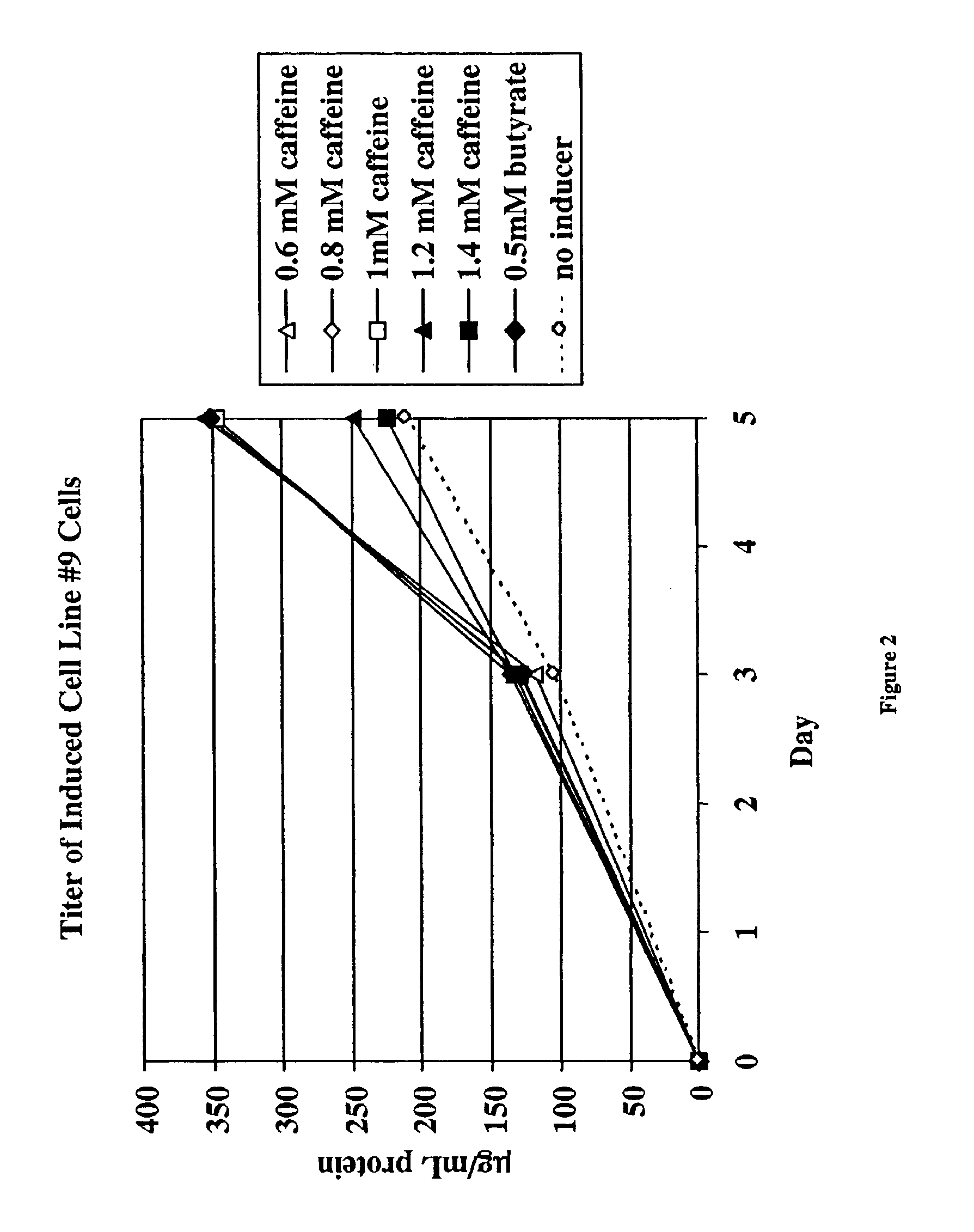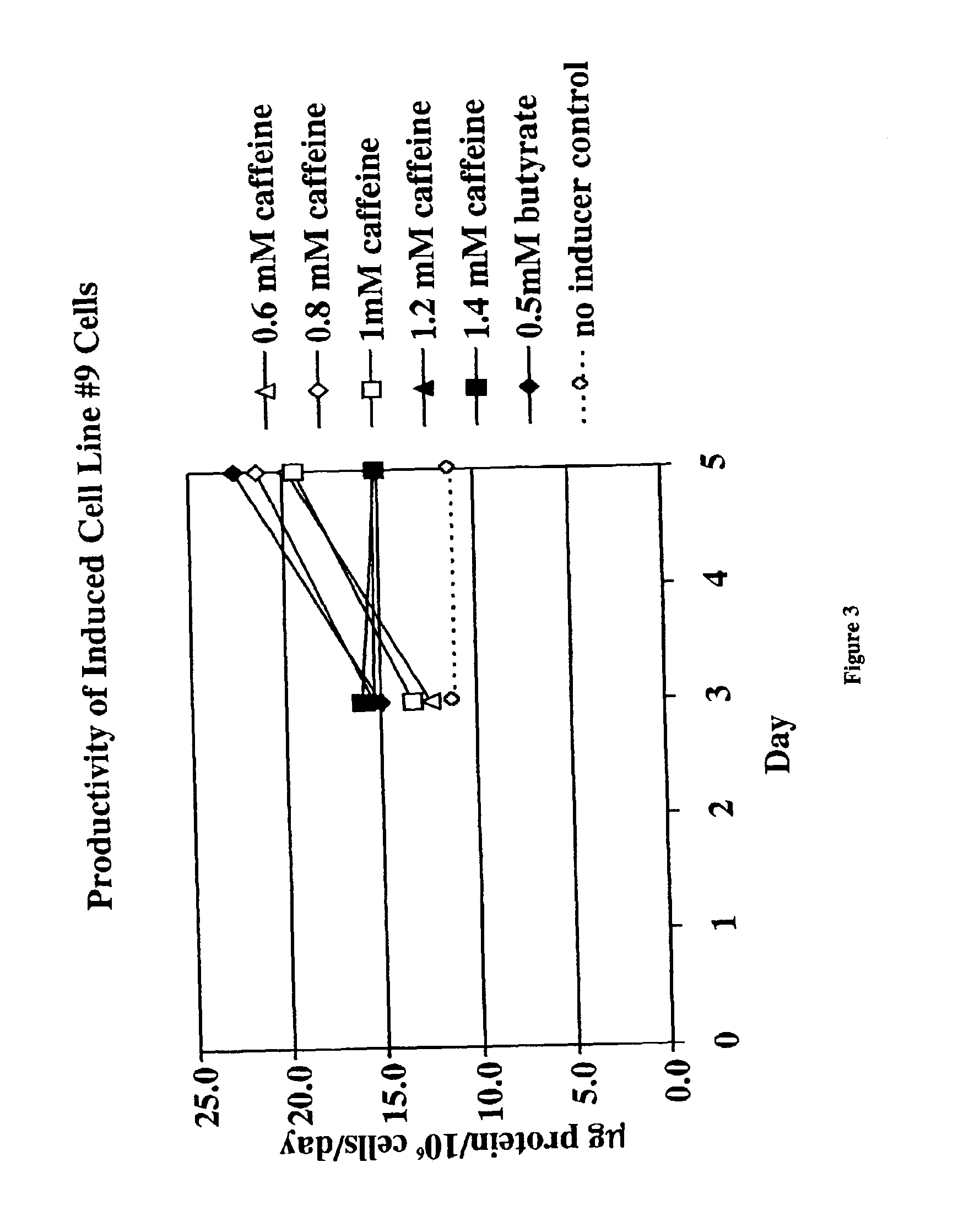Methods for increasing polypeptide production
a polypeptide and polypeptide technology, applied in the field of polypeptide production, can solve the problems of insufficient polypeptide quality, limited culture facilities, and high cost of specific polypeptide isolation from natural sources, and achieve the effect of increasing polypeptide expression
- Summary
- Abstract
- Description
- Claims
- Application Information
AI Technical Summary
Benefits of technology
Problems solved by technology
Method used
Image
Examples
example 1
Comparison of the Inducing Activity of Caffeine and Butyrate at 31° C.
In this experiment, caffeine (at concentrations from 0.5 to 2.0 mM) was compared to sodium butyrate for its ability to induce expression of a recombinant polypeptide. A CHO cell production line genetically engineered to express TNFR:Fc (cell line #5) was used to test the effectiveness of caffeine as an inducing agent. CHO cells were grown in spinner flasks at 37° C. using serum-free growth medium containing methotrexate. When the appropriate cell mass was obtained, the cells were placed into induction conditions by a five minute centrifugation at 1000×g, followed by replacement of the growth medium with serum-free medium without methotrexate. The cells, at initial cell densities of 2×106 cells / ml in 20 ml, were placed in 125 ml plastic Erlenmeyer flasks with plug seal caps and placed on shaker platforms in incubators set to the appropriate temperatures. Cell viability and number were monitored by haemocytometer co...
example 2
Induction of Recombinant Polypeptide Expression in Cell Line #9
In this experiment, the effect of caffeine (at concentrations from 0 to 1.4 mM) on the induction of expression of a different recombinant polypeptide, a soluble form of the IL-1 receptor type II, in a second CHO cell line (cell line #9) was examined.
CHO cells were grown in spinner flasks at 37° C. using serum-free growth medium containing methotrexate. When the appropriate cell mass was obtained, spent medium was removed by a five minute centrifugation at 1000×g and replaced with production medium without methotrexate. The cells, with initial cell densities of 2×106 cells / ml in 20 ml, were placed in 125 ml plastic Erlenmeyer flasks with plug seal caps. The following caffeine concentrations were tested: 0, 0.6, 0.8, 1.0, 1.2, and 1.4 mM caffeine. The flasks were then incubated in this induction phase for 5 days at 31° C. in incubators without carbon dioxide control. Cell viability and number were monitored by haemocytomet...
example 3
Induction Of Recombinant Polypeptide Expression In Cell Line #60
In this experiment, the use of caffeine to induce recombinant production from a third CHO cell line (cell line #60) expressing a third recombinant product, a human antibody that recognizes epidermal growth factor receptor, was analyzed. For this cell line, the inducing effects of 0, 0.5, 1.0, 1.5, and 2.0 mM caffeine were tested, and the experiment was conducted as in the previous experiment except that the induction phase was performed at 36° C.
At day 5, the flask of cells with no inducer and the flask of cells induced with 0.5 mM caffeine exhibited the highest cell viabilities (about 76%) of all the conditions. Viabilities of cultures containing 1.0 mM and 1.5 mM caffeine were about 68% and 60%, respectively. Cultures containing 0.75 mM butyrate or 2.0 mM caffeine were about 51% viable. Thus viability, overall, was lower than that seen in cell line #9 at 5 days, an effect that might be attributed to a variety of facto...
PUM
| Property | Measurement | Unit |
|---|---|---|
| temperature | aaaaa | aaaaa |
| temperature | aaaaa | aaaaa |
| temperature | aaaaa | aaaaa |
Abstract
Description
Claims
Application Information
 Login to View More
Login to View More - R&D
- Intellectual Property
- Life Sciences
- Materials
- Tech Scout
- Unparalleled Data Quality
- Higher Quality Content
- 60% Fewer Hallucinations
Browse by: Latest US Patents, China's latest patents, Technical Efficacy Thesaurus, Application Domain, Technology Topic, Popular Technical Reports.
© 2025 PatSnap. All rights reserved.Legal|Privacy policy|Modern Slavery Act Transparency Statement|Sitemap|About US| Contact US: help@patsnap.com



